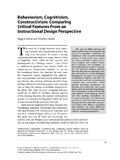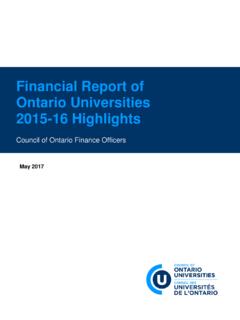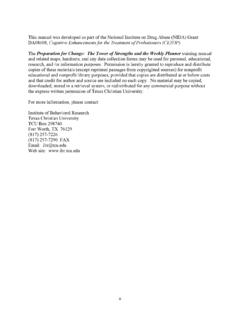Transcription of THE BALANCED SCORECARD: STRUCTURE AND USE IN …
1 THE BALANCED scorecard : STRUCTURE AND USE IN CANADIAN COMPANIES A Thesis Submitted to the College of Graduate Studies and Research in Partial Fulfillment of the Requirements for the Degree of Master of Science in the Department of Accounting University of Saskatchewan Saskatoon Marvin J. Soderberg Copyright Marvin Soderberg April 2006. All Rights Reserved. Use shall not be made of the material contained herein without proper acknowledgement, as indicated on the following page. i PERMISSION TO COPY The author has agreed that the library , University of Saskatchewan, may make this thesis freely available for inspection.
2 Moreover, the author has agreed that permission for extensive copying of this thesis for scholarly purposes may be granted by the professor who supervised the thesis work recorded herein or, in his absence, by the Head of the Department of Accounting, or the Dean of the College of Commerce. It is understood that due recognition will be given to the author of this thesis and to the University of Saskatchewan in any use of the material in this thesis. Copying or publication or any other use of the thesis for financial gain without approval by the University of Saskatchewan and the author s written permission is prohibited.
3 Requests for permission to copy or make any use of the material in this thesis in whole or in part should be addressed to: Head of the Department of Accounting University of Saskatchewan Saskatoon, Saskatchewan Canada ii ABSTRACT This thesis develops a BALANCED scorecard model based on the attributes of Kaplan and Norton s BALANCED scorecard (1992, 1996, 2001). The model is then operationalized using a survey that is administered to CMAs (Certified Management Accountants) employed by for profit, Canadian companies with greater than 51 employees. One hundred and forty nine usable responses were received.
4 The thesis attempts to answer two research questions: (1) What attributes of a Kaplan & Norton (hereafter K&N) BALANCED scorecard (BSC) are present in the performance measurement systems of Canadian organizations? and (2) What are the differences between organizations with different levels of K&N BALANCED scorecard adoption? Of the 149 responses, 110 ( ) organizations were classified as BSC firms (Levels 1 to 4) and 39 ( ) were classified as non-BSC firms. The 110 BSC firms were further classified as follows: 15 ( ) as Level 1 BSC firms, 14 ( ) as Level 2A BSC firms, 20 ( ) as Level 2B BSC firms, 25 ( ) as Level 3 BSC firms and 36 ( ) as Level 4 BSC firms.
5 Thus, based on our conceptual model, we can say that of the BSC firms ( of the total respondents) had a fully developed K&N BSC. The study found several differences between Level 4 and Level 1 BSC organizations. For example, respondents in 83% of the Level 4 organizations, versus in 67% of the Level 1 organizations, indicated that their organizations reviewed their performance measures when their strategy changed. This study adds to academic research by conceptualizing Kaplan and Norton s (1996, 2001) BALANCED scorecard and comparing this to the performance measurement systems of Canadian companies.
6 Although there are numerous academic studies on the BALANCED scorecard ( , Chan & Ho 2000; Hoque & James 2000; Lipe & Salterio 2000, 2002; Malina & Selto 2001; Ittner & Larcker 2003; Speckbacher et al. 2003; Stemsrudhagen 2004), only the Speckbacker et al. 2003 study has developed a conceptual model of Kaplan and Norton s (1992, 1996, 2001) BALANCED scorecard and used it to examine the extent of its adoption. Our study mirrors theirs, with two notable exceptions: we have a different and noteworthy conceptualization of Kaplan and Norton s BALANCED scorecard and we apply this to a Canadian setting.
7 Iii ACKNOWLEDGEMENTS First and foremost I thank my family (my wife Valerie and our children Jennifer, Michael, Alana and Nicole) for their support and patience while I worked on this project. Several other people contributed and need to be mentioned. My Aunt Hilma who provided my with a place to stay when I came to Saskatoon. Many of my friends contributed: Jim and Theresa picked me up at the bus depot many times, lent me their bike and often fed me superb meals; Gary Short gave me a hand when I needed it the most and made it easier for me to continue; Koreen Geres was always encouraging and eager to hear how things were going and made me feel that I could finish; Chima Mgabwu, a fellow MSc.
8 Colleague proof read my thesis and provided me with suggestions and amendments. Finally, I am most indebted to my thesis committee who played a major role in this project. Doctors Kalagnanam, Vaidyanathan and Sheehan willingly gave their time, knowledge and patience to this project. iv TABLE OF CONTENTS PERMISSION TO TABLE OF LIST OF LIST OF LIST OF CHAPTER FOCUS OF THE LITERATURE RESEARCH CONTRIBUTIONS OF THE CHAPTER MEASURES DERIVED FROM CAUSAL PLANNING AND STRATEGIC (DOUBLE-LOOP LEARNING)..13 BALANCED scorecard PREVIOUS BALANCED scorecard STUDIES RELATING TO THE STRUCTURE ATTRIBUTE OF THE BSC STUDIES RELATING TO THE USE ATTRIBUTE OF THE BSC CHAPTER RESEARCH SURVEY ALIGNMENT OF THE QUESTIONNAIRE WITH THE BALANCED scorecard LEVEL 1 LEVELS 2A, 2B, AND LEVEL 3 LEVEL 4 SAMPLE SURVEY STATISTICAL SURVEY v CHAPTER RESULTS PERTAINING TO RESEARCH QUESTION LEVEL 1 BALANCED scorecard (DERIVED FROM STRATEGY).
9 37 NO BALANCED LEVEL 2A BSC (LEVEL 1 BSC WITH BALANCE)..38 LEVEL 2B BSC (LEVEL 1 BSC WITH CAUSAL LINKAGES)..39 LEVEL 3 BALANCED LEVEL 4 BALANCED SUMMARY OF RESEARCH QUESTION 1 RESULTS PERTAINING TO RESEARCH QUESTION PERFORMANCE MEASUREMENT SYSTEM PERFORMANCE GOALS OF THE PERFORMANCE MEASUREMENT LINK TO DO YOU THINK YOUR PERFORMANCE MEASUREMENT SYSTEM IS A BALANCED scorecard ?..59 SUMMARY OF RESEARCH QUESTION 2 ANNUAL NUMBER OF CHAPTER CONTRIBUTIONS OF THE LIMITATIONS OF THE FUTURE APPENDIX A: CMA AND RESEARCHER COVER APPENDIX B: vi List of Tables Table Comparison of Customer Dimension Reporting with Customer Focus Table Summary of Self-Rated Performance Measures.
10 57 vii List of Charts Chart Strategy Well Understood by Chart Business Strategy not Influenced by Corporate Chart Review Measures When Strategy Chart Senior Management Involvement in Performance System Implementation46 Chart Functional Areas of Chart Deficiencies of the Performance Measurement Chart Budgeting Linked to the Performance Measurement Chart Dimensions Used in the Performance Measurement Chart Goals of the Performance Measurement System (Top Five)..53 Chart Goals of the Performance Measurement System (Next Four)..54 Chart Success of Performance Measurement Chart Self Assessed Performance Based on Return on Chart Performance Measurement System Linked to Chart Do You Think Your Performance Measurement System is a BALANCED scorecard ?








